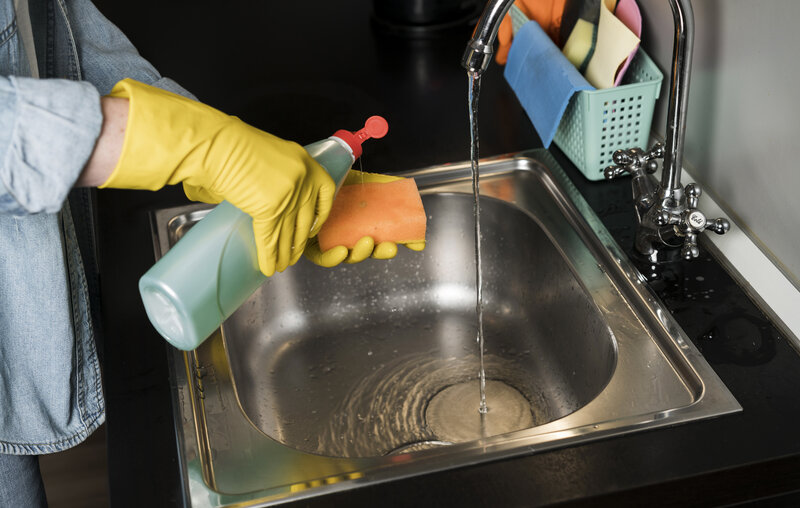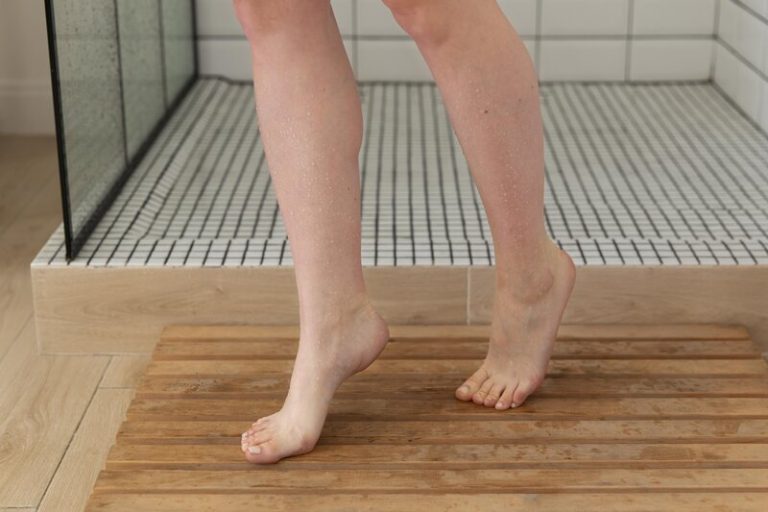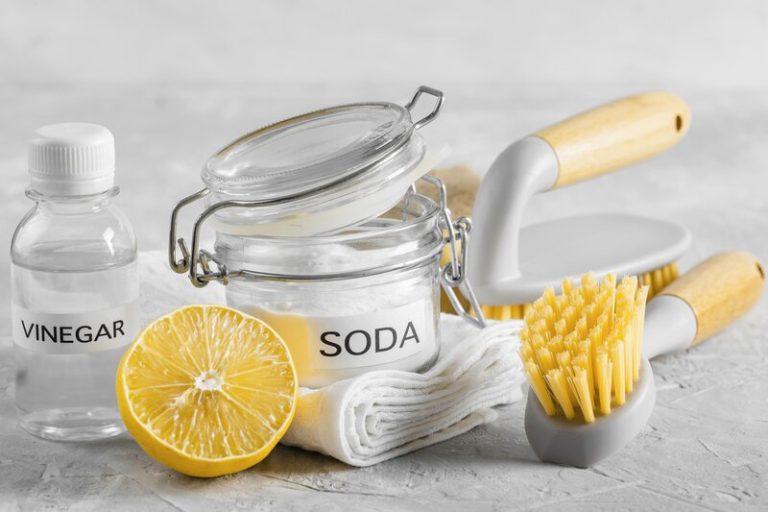Maintaining a clean and shiny stainless steel kitchen sink is essential not only for its appearance but also for a hygienic kitchen environment. If you’ve ever wondered how to clean stainless steel kitchen sink, you’re in the right place. This guide will show you effective ways to clean your sink while ensuring it remains free from stains, bacteria, and grime that can affect both the look and safety of your kitchen.
Knowing how to clean stainless steel sink properly can help prevent damage while keeping it sparkling. From using the right cleaning materials to adopting the correct techniques, this article provides the necessary steps to keep your sink in top condition.
With a little effort, you can enjoy a beautiful, hygienic kitchen sink that stays fresh and shiny for years. Let’s dive into the best practices for cleaning your stainless steel sink.
Why Is It Important to Clean a Stainless Steel Kitchen Sink?
Cleaning a stainless steel kitchen sink is crucial not only for maintaining its aesthetic appeal but also for ensuring kitchen hygiene and preventing harmful bacteria from residing on the surface. This helps create a protective layer that keeps the sink shiny and germ-free.
An unclean sink can harbour food debris and limescale build-up, which may lead to unpleasant odours, discolouration, and even potential health risks, impacting kitchen hygiene.
By regularly implementing an effective cleaning routine, which can involve natural products like bicarbonate of soda and vinegar, homeowners can protect their investment and ensure a shiny, germ-free environment with a fresh scent in their kitchens.
What Are the Materials Needed for Cleaning a Stainless Steel Kitchen Sink?
To effectively clean a stainless steel kitchen sink, you will need a selection of materials that ensure gentle yet thorough cleaning without damaging the surface, such as:
a. Mild Dish Soap
To clean your sink effectively, how to clean stainless steel kitchen sink starts with mild dish soap. It effortlessly removes grease and grime without damaging the surface. Whether you’re cleaning after meals or wiping down counters, this gentle cleanser is a kitchen essential. Regular use ensures a shiny, hygienic sink while maintaining the surface’s integrity.
b. Bicarbonate of soda
Bicarbonate of soda is perfect for tough stains on your stainless steel kitchen sink. Create a paste with water and apply it to stains, leaving it for 10-15 minutes before scrubbing. This powerful natural cleaner removes grime and neutralizes odours, leaving your sink sparkling clean without causing any damage to the surface.
c. Vinegar
Vinegar, when used with bicarbonate of soda, is a powerful combination for cleaning stainless steel kitchen sinks. The fizzing action lifts dirt and grime while deodorizing the surface. Pour vinegar into the sink, sprinkle bicarbonate of soda, and scrub gently for a sparkling, fresh result. Always rinse thoroughly to avoid residue build-up.
d. Lemon or Orange Peel
For a fresh and eco-friendly touch to how to clean stainless steel kitchen sink, use lemon or orange peels. The citric acid in the peels naturally tackles stains and grease, while leaving behind a pleasant citrus scent. Simply rub the peels on the surface for a sparkling clean, all while avoiding harsh chemicals.
e. Soft Cloth or Sponge
A soft cloth or non-abrasive sponge is essential when learning how to clean stainless steel kitchen sink. These materials prevent scratches while effectively removing dirt and grime. Always use gentle tools to maintain the sink’s shine and longevity, ensuring that the protective layer remains intact for a long-lasting finish..
f. Microfibre Cloth
Microfibre cloths are perfect for polishing your stainless steel kitchen sink. Their ultra-fine fibres trap dirt and prevent streaks, leaving the sink gleaming. These cloths require minimal cleaning agents, making them both environmentally friendly and highly effective at maintaining your sink’s shine without damaging the surface.
Step-by-Step Guide on How to Clean a Stainless Steel Kitchen Sink
This step-by-step guide will take you through the effective cleaning process for a stainless steel kitchen sink, ensuring it remains free from food debris, germs, and tough stains while restoring its shine.
a. Rinse the Sink
Begin by rinsing your stainless steel kitchen sink thoroughly with warm water to remove any food debris, grease, or residue. This step is crucial because it prevents stains from setting in and helps minimize the chances of water spots forming.
By ensuring the sink is free from loose particles, you prepare the surface for the next cleaning steps, making them more effective and ensuring the stainless steel remains gleaming.
b. Apply the Cleaning Solution
Once the sink is prepped, apply your chosen cleaning solution, such as a bicarbonate of soda paste or a vinegar spray. When learning how to clean stainless steel kitchen sink, it’s essential to dry the sink first, as this allows the solution to stick better and work more effectively.
If using a bicarbonate paste, let it sit for 15-20 minutes, while a vinegar spray should be generously applied. These eco-friendly solutions are perfect for a deep clean without harsh chemicals.
c. Scrub the Sink
Using a soft cloth or a non-abrasive sponge, gently scrub the sink to remove tough stains, limescale, or leftover food particles. When figuring out how to clean stainless steel kitchen sink, remember to go easy with your scrubbing technique.
The goal is to clean without scratching the surface, so choose a microfibre cloth or sponge designed for stainless steel. Make sure to rinse thoroughly afterward to avoid leaving behind any cleaning residue that might attract more dirt.
d. Rinse and Dry the Sink
Once you’ve scrubbed away the grime, rinse the sink thoroughly with warm water to ensure all cleaning agents are removed. After rinsing, it’s essential to dry the sink immediately with a microfibre cloth. Drying helps prevent water spots from forming and restores the shine.
Proper rinsing and drying not only enhance the appearance of your stainless steel kitchen sink but also maintain its durability, ensuring a polished look that lasts longer.
How to Remove Stains from a Stainless Steel Kitchen Sink?
Removing stains from a stainless steel kitchen sink can be effective when using a combination of natural solutions such as bicarbonate of soda and vinegar, or opting for a commercial stainless steel cleaner for tougher stains.
a. Use Bicarbonate of soda and Vinegar
When wondering how to clean stainless steel kitchen sink, a powerful natural combination of bicarbonate of soda and vinegar can help eliminate stubborn stains.
Simply sprinkle the baking soda over the stained area, then pour vinegar on top and let the mixture bubble. After 10-15 minutes, scrub with a soft cloth and rinse with warm water. This method provides an effective, chemical-free solution for a sparkling clean sink.
b. Use Lemon or Orange Peel
To tackle stains naturally, how to clean stainless steel kitchen sink can be made easier with lemon or orange peels. The acidity and oils from the peel work as a gentle scrub to lift stains and leave a fresh scent.
Simply rub the inner side of the peel onto the stained areas, and after cleaning, let the peels rest in the sink for a lingering citrus fragrance. It’s a natural, eco-friendly approach to maintaining your sink’s shine.
c. Use a Commercial Stainless Steel Cleaner
For those tough stains that natural solutions can’t handle, using a commercial stainless steel cleaner is a great choice when wondering how to clean stainless steel kitchen sink. These products are specifically formulated to tackle difficult grime, offering a professional-level clean.
After identifying the stain, apply the cleaner according to the instructions, and rinse thoroughly. This method ensures that your sink regains its polished, gleaming appearance, even after enduring tough stains.
Tips for Maintaining a Clean and Shiny Stainless Steel Kitchen Sink
To keep your stainless steel kitchen sink looking clean and shiny, it’s essential to adopt a maintenance routine that includes daily wipes, deep clean sessions, and proper cleaning techniques to preserve its protective layer.
a. Daily Wipes
To keep your sink looking pristine, wipe down your stainless steel kitchen sink daily. A quick clean with a soft cloth will remove food debris and water spots, helping to preserve its shine. Regular wiping prevents stains from setting and reduces the need for more intensive cleaning. By adopting this simple habit, you’ll maintain a gleaming sink effortlessly.
b. Deep Clean Sessions
For long-term maintenance of your sink, deep cleaning sessions are essential. Knowing how to clean stainless steel kitchen sink involves using appropriate products like vinegar or baking soda for tougher stains.
Doing this once a week will help remove built-up grime and ensure that your sink maintains its lustrous appearance. Don’t forget to dry the sink thoroughly to avoid water spots.
c. Proper Cleaning Techniques
When cleaning your stainless steel kitchen sink, always use non-abrasive cloths to avoid scratching. A gentle scrub with a natural cleaner like vinegar or mild dish soap will keep the sink’s protective layer intact.
Learning how to clean stainless steel kitchen sink the right way ensures that your sink remains shiny and free from tarnishing, while prolonging its life and enhancing your kitchen’s overall appeal.
Now that you know how to clean stainless steel kitchen sink effectively, you can maintain a gleaming and hygienic kitchen space with ease. Regular cleaning not only improves its appearance but also ensures that harmful bacteria and stains are kept at bay, preserving the longevity of your sink.
However, if you want to ensure a deeper, more thorough clean, consider using professional residential cleaning services from TEKA Cleaning. With expert care and high-quality products, TEKA Cleaning guarantees spotless results, saving you time and effort.
For a hassle-free cleaning experience, call TEKA Cleaning today at 01223 751 544 and let us handle the tough cleaning tasks for you!
Read also:











